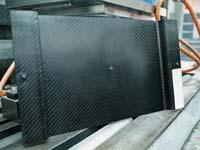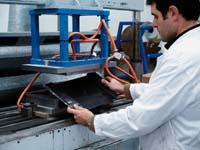Light carbon cars
2008/01/01 Kortabitarte Egiguren, Irati - Elhuyar Zientzia Iturria: Elhuyar aldizkaria

The European Commission has proposed reducing carbon dioxide emissions per kilometer to 120 grams of carbon dioxide emitted by cars since 2012 (currently this measure is 140 g per kilometer). Currently few vehicles meet this requirement. In addition, less polluting cars will have to pay less taxes from 1 January 2008.
One of the options to meet these environmental goals is the lightening of cars, as reducing the weight of vehicles reduces fuel consumption. In fact, a 10% reduction in vehicle mass is estimated to reduce fuel consumption by 7%.
Mondragon Unibertsitatea is leading a research project to streamline the vehicle structure. This reduces carbon dioxide emissions and reduces the environmental impact of cars. Carbon-based materials are an option to streamline vehicle structure. These materials are used, among others, to manufacture Formula 1 cars.
Lightweight and safe
The use of carbon fibers would considerably reduce the weight of cars. This is the main advantage offered by carbon-based materials: lightness. For example, if we compare two pieces of steel with two pieces of carbon, both have a similar rigidity, but the piece of steel weighs five times more than the carbon part. In addition, carbon fibers guarantee at all times the safety and comfort of drivers and users. Its energy absorption capacity is greater than other metal structures. Therefore, in the event of a shock, carbon fibre-based materials absorb more energy, thus protecting vehicle occupants.

For example, if vehicles collide with a stalled solid object at a speed of 56 km/h, passengers should be designed not to withstand a certain deceleration (20 g). From this value considerably increases the risk of brain injury. Therefore, they must design the structure of the car to absorb kinetic energy at the time of the collision. To dissipate the kinetic energy generated in a collision with a car from 1,000 kg to 56 km/h, it is sufficient with 4.3 kg of carbon fibre-based material, provided that this material is installed in the strategic locations of the car.
There are also disadvantages
One of the obstacles to carbon-based materials is price. They are very expensive. In addition, the formula for the production of carbon fiber materials has been patented by large multinational companies, which also increases its use. On the other hand, in the current market demand has exceeded supply, which has meant a disproportionate increase in prices. Therefore, one of the objectives of the project is to achieve cheaper carbon fibers. In particular, tar treatments obtained from oil waste will be investigated, in collaboration with oil companies. It is possible that the fibers obtained are not as good as those used in the aeronautical sector, but those with sufficient quality for the automotive sector. In this sense, the experts of Mondragon Unibertsitatea have an ambitious project of the future: the implementation of a pilot plant that produces 50 tons a year.
Raw material is not the only disadvantage. In fact, compared to the production of conventional metal bodies, production processes are costly and very slow. Processes such as RTM (Resin Transfer Moulding) are currently used. In these processes, structural parts with excellent properties are obtained through thermoset resins. However, these cannot be reused and, for recycling, parts should be crushed or chemically treated.

Therefore, another objective of this project is the use of thermoplastic materials that "melt" when heated, reducing their viscosity and allowing their injection into RTM processes, at least in the first transformation. In addition, without losing the fusion capacity, other processes can be retransformed.
The most significant results will likely be released in four years. And the future of automotive goes that way, although it has not yet developed in our environment. We continue in the age of iron and aluminum.

Gai honi buruzko eduki gehiago
Elhuyarrek garatutako teknologia




